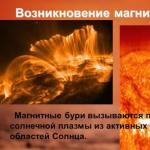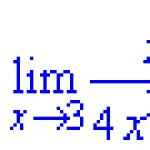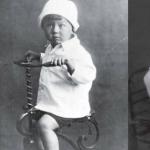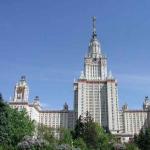What is the "apple of your eye"? Why was it good form for a guest to knock on the door with their feet? What are "laces" and why sharpen them? These and other fun facts are waiting for you in the test!
The 17th century brought many trials to the Russian state. This time is also called “rebellious”. Find out why in this quiz.
During the reign of Alexei Mikhailovich, relative calm reigned in Russia; there were no serious military upheavals. Other educational facts from this period are in this quiz.
The Patriotic War of 1812 was the liberation war of Russia against Napoleonic aggression. Check what you know about this historical event.
Tenth graders, how well do you know the history of your country? Check it out in this test!
Each century in the history of the development of Russian culture is marked by many outstanding creators in different fields of art.
In the years Soviet power There was active propaganda of the communist future, which was erected on a cult pedestal. The most striking and widespread example of propaganda of that time are Soviet posters.
Culture Ancient Rus' had high level development. From those times, mainly churches, cathedrals, icons, literature, and religious objects have survived to this day.
The beginning of writing is a special stage in the history of every people, in the development of its culture. Some facts from history Slavic writing are waiting for you in this test.
Without the discoveries of the great mathematicians of antiquity, we would probably still be using knot counting. Test your knowledge of the history of mathematics in this quiz.
Russia has experienced many wars throughout its history. Test your knowledge of the great battles (on sea and land) of wars of past centuries.
Over time, many concepts are forgotten, things that were once in every home go out of use. But science history remembers all this.
Russian victory in Patriotic War 1812 is an expression of the unyielding will and boundless determination of the people who rose up in defense of the national independence of their Motherland.
The 19th century was marked by the heyday of Russian painting. The works of Russian artists of that era have unique value and great weight in the world cultural heritage.
The collected works of V.I. Lenin were once in every library. In the USSR, there were five expanded reprints, the very first in 20 volumes, the last in 55. In addition, collections and individual works were regularly published. Lenin's legacy was studied in all schools and universities.
The writer is engaged in literary work, and the commander leads the army during the war. It would seem, what do they have in common? Both writers and generals need talent and hard work - without these qualities it is impossible to achieve success in these professions.
The philosophy of history is aimed at comprehending the meaning of universal principles and the uniqueness of the historical path of peoples and civilizations. In comprehending the history of mankind, thinkers seek the unity of all aspects of historical reality and Russia's mission in the world process.
The origin and existence of civilization Ancient Egypt connected with the Nile - people settled in the river valley and cultivated fertile lands. The achievements of civilization were the invention of hieroglyphs and management systems, the emergence of sciences, agriculture and industry, and the judicial system.
Just as the severity of laws in the USSR was softened by the optionality of their implementation, low prices were offset by the lack of goods. Memories of eternal shortages and queues were the first to be erased from memory, but the memory of cheap sausage and the most delicious ice cream continues to excite.
Knowledge of history allows us to understand by what laws the world develops. Political, economic, social systems formed as a result of long and complex processes. An objective description of past events must be based on specific dates and have documentary evidence.
Soviet leaders enriched the language with popular expressions. Many aphorisms seem funny, but there are also quite euphonious statements that have not lost their relevance. No one doubts that “less is more” and “art belongs to the people,” although not everyone remembers the author.
Perestroika was a phenomenon that changed life not only in the Soviet Union, but also in the countries of the socialist camp. Society received social and political freedom, openness and economic reform, but at the same time the USSR collapsed. The significance of perestroika is still assessed ambiguously.
While other areas of the country’s development can be debated, the issue of the “rollback” of science after the USSR is practically not disputed. During the years of Soviet power, significant funds were invested in science, the number of research institutes was constantly growing, and this was reflected in the achievements.
The sources of youth slang can be traced, but are difficult to predict. This language is distinguished from slangs by its widespread use among a certain age group. Often slang is more expressive than standard language, and this fully applies to youth slang from the times of the USSR.
At different stages Soviet Union managed to go through the stages of a new type of state, which aroused the sympathy of the working people of other countries, the liberator people who defeated fascism, the builder of communism and the “evil empire”. The chronology of events brings clarity to the pattern of processes.
Whoever Stalin really was - a dictator or the greatest political figure - we are unlikely to be able to objectively evaluate this personality. Victory in war and repression, the development of the country and the Gulag are associated with this name. The biography of this person determined the extraordinary personality.
Sections: History and social studies
Test on the topic “Primordial Rus'”
Option I (a = I)
a) Nestor;
2. Indicate the route of the trade route “From the Varangians to the Greeks”:
a) White Sea - r. Northern Dvina - r. Sukhona – Volga – Don – Sea of Azov – Black Sea;
b) Baltic Sea - r. Volkhov - lake Ilmen - Black Sea;
c) Baltic Sea – Western Dvina – Dnieper – Black Sea.
3. What are the features of Christianity compared to paganism:
a) polytheism;
b) tritheism;
c) monotheism.
4. The chronicle reports the calling of the Varangians to govern the Slavic tribes in:
a) 862;
b) 900;
c) 988.
5. The first one Russian state had a name:
a) Novgorod Rus';
b) Kievan Rus;
c) Vladimir Rus'.
6. The first Russian princely dynasty began from:
a) Sineus;
b) Truvor;
c) Rurik.
7. The first Russian prince was:
c) Svyatoslav.
8. Polyudye is:
a) Collection of tribute from vassal possessions;
b) Asking people for alms;
c) Gathering of people at the fair.
9. In 957, a magnificent embassy of Rus' went to Constantinople, to strengthen political and economic relations, led by a prince (princess):
a) Igor;
b) Olga;
c) Svyatoslav.
10. Svyatoslav dies in:
11. The first strife in Rus' occurred after death:
a) Izyaslav;
b) Yaropolk;
c) Svyatoslav.
12. The Baptism of Rus' took place in:
13. The first Russian saint was:
c) Vladimir Svyatoslavovich.
14. “Russian Truth” was first put into effect when:
a) Vladimir Monomakh;
b) Yaroslav the Wise;
c) Yuri Dolgoruky.
15. In the mid-50s. XI century appeared in Rus':
a) Hagia Sophia;
b) Temple of the Savior;
c) Pechersky Monastery.
16. According to Russkaya Pravda, the punishment for premeditated murder was:
a) death penalty;
b) test by water and fire;
c) imposition of fines (fine).
17. Patrimony is:
A) land plot peasant;
b) lease of territory by an artisan;
c) land ownership transferred by the prince to his vassals.
18. Rich merchants conducting foreign trade were called:
a) “Guests”;
b) “Foreigners”;
c) “Strangers”.
19. Slavic alphabet was called:
a) cursive writing;
b) Cyrillic;
c) initial letter.
20. Boyars were called:
a) the prince’s junior warriors;
b) The prince’s senior warriors;
c) representatives of the clergy.
21. The Lyubech Congress took place in:
22. Find a work written by Vladimir Monomakh:
a) “The Word about the destruction of the Russian land”;
b) “Teaching to children”;
c) “Nomocanon”.
Questions (a = I)
- Name the Russian prince who tried to restore peace in Rus' and prevent its disintegration into fiefs.
- What do slaves, servants, purchasers, captives, hirelings have in common?
- Whose portrait is this: “He had a red face, big eyes, not very tall in stature, but strong in body and strong.”
- To whom is the following phrase addressed: “Our land is great and abundant, but there is no order (i.e. management) in it. Come reign and rule over us.”
- Who owns the new and lasting system of the unity of Rus' - the transfer of grand ducal power by seniority?
- Which city is called the “mother of Russian cities”?
- From which document is the following phrase taken: “We are from the Russian family... sent from Oleg, the Grand Duke of Russia, and from everyone who is under his hand - the saints and great princes, and his great boyars...”
- What unites the large boyars, rich merchants, and archbishops.
Standard answers
For the test
1-a; 2-b; 3-in; 4-a; 5 B; 6-in; 7-b; 8-a; 9-b; 10-v; 11-v; 12-a; 13-v; 14-b; 15-v; 16-in; 17-v; 18-a; 19-b; 20-b; 21-v; 22-b.
For questions
- Vladimir Monomakh.
- All are dependent, unfree people.
- Yaroslav the Wise.
- Varangians.
- Yaroslav the Wise.
- Kyiv.
- Treaty between Byzantium and Russia in 911.
- They are all urban aristocracy.
Evaluation criteria:
- “5” – 28-30 correct answers;
- “4” – 23-27 correct answers;
- “3” – 15-22 correct answers;
- “2” – less than 15 correct answers.
II option (a = II)
1. In what language were chronicles compiled in Kievan Rus:
a) in Latin;
b) in Slavic;
c) in Russian.
2. What did Russian merchants trade?
a) fish, salt, furs, leather, honey, linen;
b) incense and spices, beads, wine;
c) weapons, horses, precious stones, fabrics.
3. Indicate the main types of economic activity of the Slavs:
a) gardening and winemaking;
b) agriculture;
c) cattle breeding.
4. In the 9th century. Eastern Slavs were:
a) pagans;
b) Christians;
c) Muslims.
5. What is the name of the theory of the origin of the Russian state?
a) Varyazhskaya;
b) Norman;
c) Indo-European.
6. In what year did Kyiv become the center of a single ancient Russian state?
7. What was the name of the meeting of free people - members of the community among the Eastern Slavs?
8. One of the reasons for the Russian-Byzantine war of 941 - 944. was:
a) non-payment of tribute by Byzantium;
b) a ban by the Russian prince on trade in Byzantium;
c) abolition of benefits for Russian traders.
9. Name Slavic tribe, which did not want to pay tribute to Kyiv and constantly rebelled against Prince Igor.
a) clearing;
b) Drevlyans;
c) Krivichi.
10. In what year did Princess Olga receive baptism?
11. Why is Svyatoslav called “Alexander the Great” of Eastern Europe?
a) Due to the constant conflict with Byzantium;
b) Because of his campaigns and annexed lands;
c) Because of Svyatoslav’s unusual diplomacy.
12. In an effort to protect the southern borders of Rus' from the constant raids of the Pechenegs, Vladimir undertook?
a) Construction of outposts with a light warning system;
b) Creation of border guards;
c) Construction of ditches around Russian cities.
13. What is one of the reasons why Vladimir chose Christianity to unite the Russian lands?
a) did not obligate anyone to anything;
b) It could cleanse the soul, provide an opportunity for revival and renewal of personality, hope; for a happy life in eternity.
14. What is vira?
a) ransom given by the grooms to the bride’s family;
b) judicial duel;
c) court fee for murder or injury inflicted on a person.
15. What event of the 11th century shows the growth of the international authority of Rus'.
a) Payment of indemnity by Byzantium;
b) Russian conquest of Constantinople;
c) Marriage of a Byzantine princess and the son of Yaroslav.
16.Name the first monk of the Pechersk Monastery?
a) Hilarion;
b) Anthony;
c) Theodosius.
17. Princely domain is:
a) Lands belonging to the prince’s warriors;
b) A complex of lands inhabited by people belonging directly to the head of state;
c) Church lands.
18. What tasks did cities perform during the formation of the state and the development of Rus'?
a) Place for gathering troops to repel the enemy;
b) Trade and craft centers;
c) Centers for the association of farmers.
19. Tithe is:
a) a tenth of the prince’s income in favor of the church;
b) the name of the church lands;
c) monetary unit in Rus'.
20. What decision was made by the princes at the Lyubech congress in 1097?
a) All Russian principalities should unite into single state with center in Kyiv;
b) Each prince retains the lands of their fathers;
c) Strong princes can take over other principalities.
21. What event happened in 1111?
a) Peasant revolt;
b) Crusade against the Polovtsians;
c) Russian-Byzantine War.
22. By the middle of the 12th century, Rus' split into:
a) 10 principalities;
b) 12 principalities;
c) 15 principalities.
Questions (a = II)
- Who owns the following description: “Possessing no physical strength, being lame, he was a brave warrior and fearlessly led the army into battle. Born into a pagan environment, he became a true Christian. He showed himself to be an extremely versatile person. Remained in history as a major urban planner. In honor of victories over enemies, he built the “Golden Gate”.
- List the main categories of the population during the period of “military democracy”. Arrange them in descending order of wealth and power.
- Determine who, the Greek historian wrote: “Their justice was imprinted in their minds, and not in their laws... they lead the same way of life, have the same morals, love freedom and cannot stand slavery,... excellent wars... Their greatest art is that they know how to hide in rivers under water.”
- Determine who we're talking about: “Rural estates and city courtyards of the secular and ecclesiastical nobility were full of these people, who performed many jobs around the house and in the field. But they were still different from slaves in the ancient world. They had some rights. Their murder was punishable by law.”
- Who is the following message intended for? “Prince! There is no sin for you: after all, they always, having taken an oath, destroy the Russian land and shed Christian blood incessantly?”
- Determine who we are talking about: “During the collection of tribute in 945, the warriors of this prince committed violence against the Drevlyans. Having collected the tribute, the prince sent the main part of the squad and the convoy home, and he himself, remaining with his “small squad, decided to wander around the Drevlyan lands in search of booty. The Drevlyans, led by their prince Mal, rebelled and killed the squad. The offender himself was captured and executed with a cruel death: he was tied to two bent trees, and then they were released.”
- Whose next characteristic? “From the first steps of her reign, she showed herself to be a decisive, powerful, far-sighted and stern ruler. She took revenge on the Drevlyans for the death of her husband. And she established standards for paying tribute for the local population and places where the tribute was to be taken. Dying, the princess bequeathed not to celebrate a pagan funeral feast at her grave, but to bury her according to Christian custom.”
- Who owns the following words: “I don’t like to sit in Kiev, I want to live in Pereyaslavets on the Danube - there is the middle of my land, all the good things flow there: from the Greek land - gold, drags (precious stones), wines, various fruits from the Czech Republic, from Hungary – silver and horses, and from Rus' – fur and wax, honey and slaves.”
The All-Russian Test Work (VPR) is intended for the final assessment of the educational training of graduates who have studied a school history course at basic level.
The All-Russian test is aimed at identifying the level of graduates’ mastery of basic historical knowledge, experience in applying the historical and cultural approach to assessing social phenomena, the ability to apply historical knowledge to understand the essence of social phenomena, the ability to search, analyze, compare and evaluate information about events and events contained in various sources. phenomena of the past. The VPR also tests graduates’ knowledge of the history and culture of their native land.
The VPR includes tasks on the history of Russia from ancient times to the present day and the history of our native land. Knowledge of general history are tested in the work only in the context of Russian history.
The work consists of 12 tasks. 1.5 hours (90 minutes) are allotted to complete the entire work.

Target audience: for 11th grade
The test is presented in four versions. There are answers. The work consists of nine tasks. The maximum initial score for the work is 11. 45 minutes are allotted to complete the work.


Target audience: for 9th grade
Appointment of CMM for carrying out test work in history - to assess the quality of general education training in history for 8th grade students in accordance with the requirements of the Federal State Educational Standard. VPR CMMs make it possible to diagnose the achievement of subject and meta-subject results learning, including mastery of interdisciplinary concepts and the ability to use universal learning activities (UAL) in educational, cognitive and social practice. The results of the VPR, together with the information available in the general education organization, reflecting the individual educational trajectories of students, can be used to assess personal results training.


Target audience: for 8th grade
The purpose of the KIM for conducting tests in history is to assess the quality of general education training in history for 7th grade students in accordance with the requirements of the Federal State Educational Standard.
You are given 60 minutes to complete the history work. The work includes 12 tasks. Part 1 of the work is devoted to the history of Russia and the history of foreign countries (history of modern times), in part 2 a task is proposed on the history of your native land.


Target audience: for 7th grade
Published in the archive:
- description of the VPR in history, including a Codifier of content elements and requirements for the level of training of graduates educational organizations for carrying out VPR. The codifier is compiled on the basis of the Federal component of state standards of basic general and secondary (full) general education to study the subject at a basic level. The description of the VPR contains information about the distribution of tasks in the work according to content blocks and tested methods of action, about the evaluation system for individual tasks and work as a whole.
- a sample of the All-Russian test work, which gives an idea of the structure of the All-Russian test work, the number and form of tasks, and their level of complexity.
- answers and assessment criteria to the test sample.


Target audience: for 6th grade
All-Russian testing works (VPR) are carried out taking into account the national, cultural and linguistic specifics of the multinational Russian society in order to monitor the results of the transition to the Federal State Educational Standard and are aimed at identifying the quality of students’ training.
The purpose of the KIM for conducting tests in history is to assess the quality of general education training in history for 5th grade students in accordance with the requirements of the Federal State Educational Standard. KIM VPR make it possible to diagnose the achievement of subject and meta-subject learning outcomes, including mastery of interdisciplinary concepts and the ability to use universal learning activities (UAL) in educational, cognitive and social practice.




